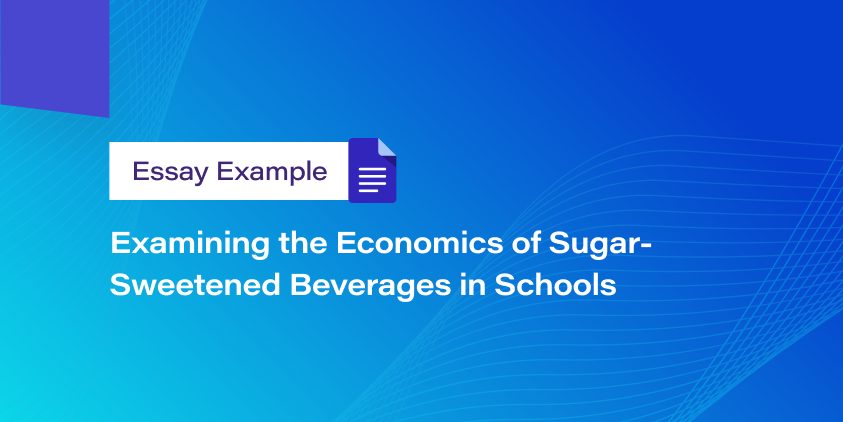Examining the Economics of Sugar-Sweetened Beverages in Schools

Beverages sweetened with sugar are controversial brand products. The main issue surrounding the beverages is the health impact on the consumers (Mello, Pomeranz, and Moran, 2008). Children are the major consumers of these products, and there is a potential for the same to cause child obesity (Mello, Pomeranz, and Moran, 2008). As such, there have been suggestions to restrict the sale of such products in or near schools, but this has been objected consumers, parent groups, and producers (Mello, Pomeranz, and Moran, 2008). The companies have adopted voluntary measures to reduce the sale of the beverages, but the question now is whether policies should regulate the same issue (Mello, Pomeranz, and Moran, 2008). The issue relates to economic efficiencies, namely allocative, production and technical efficiencies, and normative and positive economics concepts. Based on the controversy surrounding the need for policies, the issue arouses different perspectives based on the economic efficiencies and the positive and normative economics described in this essay.
The issue of regulating the sale of beverages sweetened with sugar fits in the concept of efficiency in favor of the absence of policies regulating the sale of products to students. Firstly, allocative efficiency concerns the allocation of resources based on the effectiveness of the project in question (Ouattara, 2012). In this regard, if the manufacture and sale of the beverages give attractive returns to the manufacturers, then there is a justification for the firm to produce and sell the products. Secondly, production efficiency deals with the ratio between the output and the factors that facilitate its production (Ouattara, 2012). As such, as long as the manufacturers of beverages earn higher returns than the costs of production, then there is no problem with producing sugar-sweetened beverages. Thirdly, technical efficiency is the ratio of inputs compared to the market price (Ouattara, 2012). In this case, if the firm as long as the firm uses a ratio of inputs that are favorable according to the prices in the market, then there is no harm if the firm manufactures and sells the products. From the discussion provided above, it is clear that the concept of efficiency supports the manufacture and sale of sugar-sweetened beverages, and hence, there is no need for policies to regulate the issue.
The concepts of normative and positive economics have different implications on the issue of the sale of beverages in schools. Normative economics entails what should be or the desired status (Caplan and Miller, 2010). As such, normative economics would prescribe the adoption of rules/policies to regulate the sale of beverages in schools (Mello, Pomeranz, and Moran, 2008). Positive economics entails the current situation (Caplan and Miller, 2010). As per the situation, the companies have adopted voluntary measures to control the sale of beverages to children, but there are no policies on the same, which is the current status (Mello, Pomeranz, and Moran, 2008). From the information provided, normative economics would call for adopting restriction policies, while positive economics would call for things to remain the same.
In conclusion, sweetened beverages are controversial due to the promotion of obesity in children. The manufacturers have adopted voluntary measures to restrict the sale of the stuff to children, but there needs to be a policy towards the same; hence, there are questions about whether such laws are necessary. The economic efficiencies the normative and positive economics arouse various perspectives on whether such laws are necessary. The economic efficiencies of allocation, production, and technicality favor the manufacture and sale of the products; hence, these are against the laws. Positive economics considers the present status; hence, it is against the laws, while normative economics considers what should be and thus supports the laws. From the provided discussion, it is evident that the economic efficiencies have the same stance toward adopting the policy, while the positive and normative economics have divergent views.
📎 References:
1. Caplan B. & Miller S. (2010). Positive versus normative economics: what’s the connection? Evidence from the Survey of Americans and Economists on the Economy and the General Social Survey. The United States of America. Retrieved from https://econfaculty.gmu.edu/bcaplan/pdfs/positiveversus.pdf
2. Ouattara W. (2012). Economic Efficiency Analysis in Côte d’Ivoire: American Journal of Economics, 2(1): 37-46. Retrieved from http://article.sapub.org/pdf/10.5923.j.economics.20120201.05.pdf
3. Mello M., Pomeranz J., & Moran P. (2008). The Interplay of Public Health Law and Industry Self-Regulation: The Case of Sugar-Sweetened Beverage Sales in Schools. American Journal of Public Health, April; 98(4): 595–604. Retrieved from https://www.ncbi.nlm.nih.gov/pmc/articles/PMC2376983/
